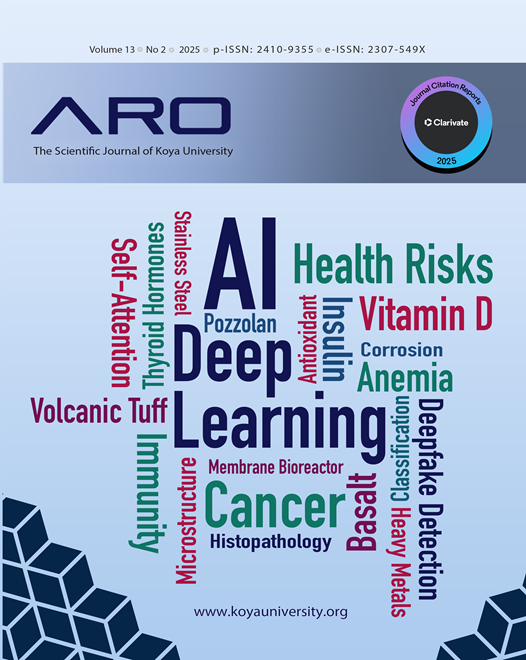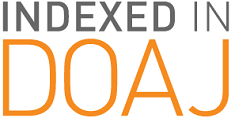Health Risk Assessment of Heavy Metals in Indoor Dust in Erbil City
DOI:
https://doi.org/10.14500/aro.12215Keywords:
Hazard index, Hazard quotient, Health risk, Heavy metal, Indoor dustAbstract
Indoor dust is a significant source of heavy metal exposure, posing potential health risks to residents. This study investigates the concentration and possible health risks of heavy metals in household dust in Erbil City, Kurdistan Region of Iraq, and assesses the associated health risks. 123 indoor dust samples were collected from various residential areas and analyzed using Energy Dispersive X-ray spectroscopy, an advanced technique that enables precise elemental detection. The metals assessed included aluminum (Al), iron (Fe), titanium (Ti), arsenic (As), chromium (Cr), nickel (Ni), cadmium (Cd), and lead (Pb). The highest mean concentrations were observed for aluminum (Al), particularly in the Northwest region (29209 mg/kg), while lead (Pb) exhibited the lowest concentration in the same Northwest region (28 mg/kg). Notably, elevated levels of titanium (Ti) were detected in the northern area, and cadmium (Cd) was most pronounced in the Northeast, reflecting spatial variation potentially linked to traffic emissions, construction activity, and indoor smoking. To evaluate the potential health implications, hazard quotients and hazard indices (HI) are calculated for both children and adults, focusing on non-carcinogenic risks through inhalation exposure in accordance with the United States Environmental Protection Agency guidelines. Although localized HQ values were higher for certain elements, such as Ti and Cd, all calculated HI values remained below the threshold value of 1. This indicates that under current environmental conditions, indoor dust in Erbil City is unlikely to pose significant non-carcinogenic health risks through inhalation.
Downloads
References
Abd Mutalib, M., Rahman, M.A., Othman, M.H.D., Ismail, A.F., and Jaafar, J., 2017. Scanning electron microscopy (SEM) and energy-dispersive x-ray (EDX) spectroscopy. Membrane Characterization, 1, pp.161-179. DOI: https://doi.org/10.1016/B978-0-444-63776-5.00009-7
Al-Dulaimi, E., Shartooh, S.M., and Al-Heety, E.A., 2021. Concentration,distribution, and potential sources of heavy metals in households dust in Al-Fallujah, Iraq. Institute of Gems and Jewellery, 54, pp.120-130. DOI: https://doi.org/10.46717/igj.54.2F.11ms-2021-12-28
Alghamdi, A.G., EL-Saeid, M.H., Alzahrani, A.J., and Ibrahim, H.M., 2022. Heavy metal pollution and associated health risk assessment of urban dust in Riyadh, Saudi Arabia. PLoS One, 17, p.e0261957. DOI: https://doi.org/10.1371/journal.pone.0261957
Al-Khashman, O.A., 2007. Determination of metal accumulation in deposited street dusts in Amman, Jordan. Environmental Geochemistry Health, 29, pp.1-10. DOI: https://doi.org/10.1007/s10653-006-9067-8
Al-Serhan, A.A., Al-Massaedh, “Ayat Allah”, Al-Momani, I.F., 2023. Determination of Heavy Metal Concentrations in Household Dusts in Irbid and Mafraq Cities, Jordan. Indones. J. Chem. 23, 1415. https://doi.org/10.22146/ijc.85062. DOI: https://doi.org/10.22146/ijc.85062
Amjadian, K., Pirouei, M., Rastegari Mehr, M., Shakeri, A., Khurshid Rasool,S., Ibrahim Haji, D., 2018. Contamination, health risk, mineralogical and morphological status of street dusts- case study: Erbil metropolis, Kurdistan Region-Iraq. Environmental Pollution 243, 1568–1578. https://doi.org/10.1016/j. DOI: https://doi.org/10.1016/j.envpol.2018.09.116
envpol.2018.09.116.
Carlton, R.A., 2011. Scanning electron microscopy and energy-dispersive x-ray spectrometry. In: Pharmaceutical Microscopy. Springer, New York, NY, pp. 85-130. DOI: https://doi.org/10.1007/978-1-4419-8831-7_4
Darus, F.M., Nasir, R.A., Sumari, S.M., Ismail, Z.S., and Omar, N.A., 2012. Heavy metals composition of indoor dust in nursery schools building. Procedia - Social and Behavioral Sciences, 38, pp.169-175. DOI: https://doi.org/10.1016/j.sbspro.2012.03.337
Faisal, M., Wu, Z., Wang, H., Hussain, Z., and Azam, M.I., 2021. Human health risk assessment of heavy metals in the urban road dust of Zhengzhou metropolis, China. Atmosphere, 12, p.1213. DOI: https://doi.org/10.3390/atmos12091213
Gad, A., Saleh, A., Farhat, H.I., Dawood, Y.H., and Abd El Bakey, S.M., 2022. Spatial distribution, contamination levels, and health risk assessment of potentially toxic elements in household dust in Cairo city, Egypt. Toxics, 10, p.466. DOI: https://doi.org/10.3390/toxics10080466
Girão, A.V., Caputo, G., and Ferro, M.C., 2017. Application of scanning electron microscopy-energy dispersive x-ray spectroscopy (SEM-EDS). Comprehensive Analytical Chemistry, 75, pp. 153-168. DOI: https://doi.org/10.1016/bs.coac.2016.10.002
Gul, H.K., Gullu, G., Babaei, P., Nikravan, A., Kurt-Karakus, P.B., and Salihoglu, G., 2023. Assessment of house dust trace elements and human exposure in Ankara, Turkey. Environmental Science Pollution Research, 30, pp.7718-7735. DOI: https://doi.org/10.1007/s11356-022-22700-x
Hammood, M.A., Chamani, A., and Sobhanardakani, S., 2024. Health risk assessment of heavy metal exposure from indoor dust: Acase study of residential buildings in Isfahan, Iran. Environmental Health Engineering Management, 11, pp.39-50. DOI: https://doi.org/10.34172/EHEM.2024.06
Hashemi, S.E., Fazlzadeh, M., Ahmadi, E., Parand, M., Ramavandi, B., Taghizadeh, F., and Arfaeinia, H., 2020. Occurrence, potential sources, in vitro bioaccessibility and health risk assessment of heavy metal in indoor dust from different microenvironment of Bushehr, Iran. Environmental Geochemistry Health, 42, pp.3641-3658. DOI: https://doi.org/10.1007/s10653-020-00598-z
Hassan, R.O., Othman Abdullah, F., Salahuddin Ali, D., Omar Othman, H., and Aziz Darwesh, D., 2024. Evaluating the health risks of heavy metal pollution in dust storms in the city of Erbil in the Kurdistan region of Iraq. International Journal of Environmental Health Research, 34, pp.3084-3100. DOI: https://doi.org/10.1080/09603123.2023.2294472
Hassan, S.K.M., 2012. Metal concentrations and distribution in the household, stairs and entryway dust of some Egyptian homes. Atmospheric Environment, 54, pp.207-215. DOI: https://doi.org/10.1016/j.atmosenv.2012.02.013
Jahandari, A., 2020. Pollution status and human health risk assessments of selected heavy metals in urban dust of 16 cities in Iran. Environmental Science Pollution Research, 27, pp.23094-23107. DOI: https://doi.org/10.1007/s11356-020-08585-8
Kurt-Karakus, P.B., 2012. Determination of heavy metals in indoor dust from Istanbul, Turkey: Estimation of the health risk. Environment International, 50, pp.47-55. DOI: https://doi.org/10.1016/j.envint.2012.09.011
Labutin, T.A., Lednev, V.N., Ilyin, A.A., and Popov, A.M., 2016. Femtosecond laser-induced breakdown spectroscopy. Journal Analytical Atomic Spectrometry, 31, pp.90-118. DOI: https://doi.org/10.1039/C5JA00301F
Mahmoud, N., Al-Shahwani, D., Al-Thani, H., and Isaifan, R.J., 2023. Risk assessment of the impact of heavy metals in urban traffic dust on human health. Atmosphere, 14, p.1049. DOI: https://doi.org/10.3390/atmos14061049
Mazumder, M., Ahmed, R., Wajahat Ali, A., and Lee, S.J., 2018. SEM and ESEM techniques used for analysis of asphalt binder and mixture: A state of the art review. Construction and Building Materials, 186, pp.313-329. DOI: https://doi.org/10.1016/j.conbuildmat.2018.07.126
Morita, M., 2018. Scanning electron microscope energy dispersive x-ray spectrometry, In: The Surface Science Society of Japan. Compendium of Surface and Interface Analysis. Springer, Singapore, pp. 557-561. DOI: https://doi.org/10.1007/978-981-10-6156-1_90
Naimabadi, A., Gholami, A., and Ramezani, A.M., 2021. Determination of heavy metals and health risk assessment in indoor dust from different functional areasin Neyshabur, Iran. Indoor and Built Environment, 30, pp.1781-1795. DOI: https://doi.org/10.1177/1420326X20963378
Rahman, M.S., Jolly, Y.N., Akter, S., Kamal, N.A., Rahman, R., Choudhury, T.R., Begum, B.A., 2021. Sources of toxic elements in indoor dust sample at export processing zone (EPZ) area: Dhaka, Bangladesh; and their impact on human health. Environmental Science Pollution Research, 28, pp.39540-39557. DOI: https://doi.org/10.1007/s11356-021-13167-3
Rasmussen, P.E., Subramanian, K.S., and Jessiman, B.J., 2001. Amulti-element profile of housedust in relation to exterior dust and soils in the city of Ottawa, Canada. Science of the Total Environment, 267, pp.125-140. DOI: https://doi.org/10.1016/S0048-9697(00)00775-0
Roy, A., Jha, A.K., Kumar, A., Bhattacharya, T., Chakraborty, S., Raval, N.P., and Kumar, M., 2024. Heavy metal pollution in indoor dust of residential, commercial, and industrial areas: A review of evolutionary trends. Air Quality Atmosphere Health, 17, pp.891-918. DOI: https://doi.org/10.1007/s11869-023-01478-y
Ruozi, B., Belletti, D., Tombesi, A., Tosi, G., Bondioli, L., Forni, F., and Vandelli, M.A., 2011. AFM, ESEM, TEM, and CLSM in liposomal characterization: A comparative study. International Journal NanoMedicine, DOI: https://doi.org/10.2147/IJN.S14615
6, pp.557-563.
Sabzevari, E., and Sobhanardakani, S., 2018. Analysis of selected heavy metals in indoor dust collected from city of khorramabad, Iran: Acase study. Jundishapur Journal Health Science, 10, p.e67382. DOI: https://doi.org/10.5812/jjhs.67382
Somsunun, K., Prapamontol, T., Kuanpan, T., Santijitpakdee, T., Kohsuwan, K., Jeytawan, N., and Thongjan, N., 2023. Health risk assessment of heavy metals in indoor household dust in urban and rural areas of Chiang Mai and Lamphun provinces, Thailand. Toxics, 11, p.1018. DOI: https://doi.org/10.3390/toxics11121018
Tan, S.Y., Praveena, S.M., Abidin, E.Z., and Cheema, M.S., 2016. A review of heavy metals in indoor dust and its human health-risk implications. Reviews on Environmental Health, 31, pp.447-456. DOI: https://doi.org/10.1515/reveh-2016-0026
Tashakor, M., Behrooz, R.D., Asvad, S.R., and Kaskaoutis, D.G., 2022. Tracing of heavy metals embedded in indoor dust particles from the industrial city of Asaluyeh, South of Iran. International Journal Environment Research Public Health, 19, p.7905. DOI: https://doi.org/10.3390/ijerph19137905
Tong, S.T.Y., and Lam, K.C., 2000. Home sweet home? A case study of household dust contamination in Hong Kong. Science of the Total Environment, 256, pp.115-123. DOI: https://doi.org/10.1016/S0048-9697(00)00471-X
USEPA. 2001. Risk Assessment Guidance for Superfund: Volume III Part A, Process for Conducting Probabilistic Risk Assessment. United States of Enviromental Protection Agency, Washington, D.C. Zararsiz, A., and Öztürk, F., 2020. Estimation of health risks associated with household dust contamination in Bolu (Turkey). Düzce Üniversitesi Bilim ve Teknoloji Dergisi, 8, PP.2245-2265. DOI: https://doi.org/10.29130/dubited.706362
Zhou, L., Liu, G., Shen, M., Hu, R., Sun, M., and Liu, Y., 2019. Characteristics and health risk assessment of heavy metals in indoor dust from different functional areas in Hefei, China. Environmental Pollution, 251, pp.839-849. DOI: https://doi.org/10.1016/j.envpol.2019.05.058
Downloads
Published
How to Cite
Issue
Section
License
Copyright (c) 2025 Nadia M. Shami, Sardar P. Yaba

This work is licensed under a Creative Commons Attribution-NonCommercial-ShareAlike 4.0 International License.
Authors who choose to publish their work with Aro agree to the following terms:
-
Authors retain the copyright to their work and grant the journal the right of first publication. The work is simultaneously licensed under a Creative Commons Attribution License [CC BY-NC-SA 4.0]. This license allows others to share the work with an acknowledgement of the work's authorship and initial publication in this journal.
-
Authors have the freedom to enter into separate agreements for the non-exclusive distribution of the journal's published version of the work. This includes options such as posting it to an institutional repository or publishing it in a book, as long as proper acknowledgement is given to its initial publication in this journal.
-
Authors are encouraged to share and post their work online, including in institutional repositories or on their personal websites, both prior to and during the submission process. This practice can lead to productive exchanges and increase the visibility and citation of the published work.
By agreeing to these terms, authors acknowledge the importance of open access and the benefits it brings to the scholarly community.
Accepted 2025-07-01
Published 2025-08-09
















 ARO Journal is a scientific, peer-reviewed, periodical, and diamond OAJ that has no APC or ASC.
ARO Journal is a scientific, peer-reviewed, periodical, and diamond OAJ that has no APC or ASC.